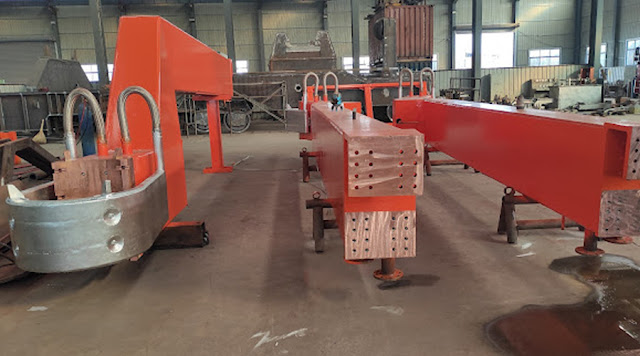Power Conductive Electrode Arm - EAF
The power conductive electrode arm of the electric arc furnace is a revolutionary milestone in metal smelting furnaces.
Electric arc furnaces (EAF) are widely used in the steelmaking industry due to their efficiency and flexibility in processing a variety of steel materials. These furnaces rely on powerful electrodes to generate intense heat and melt scrap metal, which is then refined into high-quality steel.
The Conductive Electrode Arm (PCEA) is an important part of the EAF and is responsible for providing the required power to the furnace. In this article Xi'an Hani will discuss with you the importance of electrode arms and their impact on the steelmaking process.
Features of EAF Power Conductive Electrode Arm
Traditionally, electric furnaces have used conventional electrode arms, consisting of a series of rigid copper-clad steel structures. Due to the high temperatures and currents involved in the melting process, these arms are prone to mechanical and electrical failures. However, conductive cross arms offer a more efficient and reliable solution to overcome these challenges.
The PCEA is a flexible, water-cooled arm that acts as a power conduit to continuously and efficiently transfer energy to the electrodes. Its flexibility allows optimal positioning of the electrodes, ensuring even heat distribution within the furnace. This flexibility also reduces stress on the electrodes, extending their service life and minimizing the risk of failure.
One of the main advantages of electric arc furnace electrode arms is their excellent electrical conductivity. Conductive cross arms are made of high-quality conductive materials, such as copper, with excellent electrical properties. This conductivity allows electricity to be transferred more efficiently from the source to the electrodes, reducing power losses and improving energy efficiency.
As a result, steelmakers can realize significant cost savings by reducing energy consumption and improving overall furnace performance.
In addition, Conductive cross arms's water cooling system plays a vital role in maintaining the arm temperature within the required range. The intense heat generated during the steelmaking process can cause the arm to overheat, causing structural damage and compromising its conductivity.
The water-cooling system effectively dissipates heat, ensuring that the electrode arm remains at an optimal temperature for continuous operation. This significantly improves the durability and reliability of the EAF conductive cross arms, reducing downtime and maintenance costs.
The power conductive electrode arm of EAF also provide improved safety features compared to traditional conductive cross arms. The water cooling system not only regulates the temperature of the arm, but also provides a protective barrier against potential electrical hazards.
In the event of an electrical fault, the water cooling system will act as a safety mechanism, preventing arcing and potential damage to the furnace or surrounding equipment. This improves the overall safety of the steelmaking process and protects employees from potential injuries.
In summary, the conductive electrode arm (PCEA) revolutionizes the steelmaking industry by providing a more efficient, reliable and safer solution for electric arc furnaces.
Its flexible design, superior conductivity, water cooling system and enhanced safety features help improve furnace performance, reduce energy consumption and increase operating efficiency.
As the steel industry continues to evolve, conductive cross arms remain a critical component to meet the growing demand for high-quality steel production.
E-mail: saleswn@hanrm.com / inquiry66@hanmetallurgy.com (Daisy Zhai)
Tel / Whatsapp / Wechat: 0086 17791213533
Xi'an Hani Tech Co., Ltd.



Comments
Post a Comment